Food TV in Japan and a little 'Good Luck' picspam
I saw this article today, and I immediately thought of Ogawa and Shinkai stuffing themselves on sushi in the jdorama Good Luck! They are soooo cute! Yes, my brain works in tangential ways like this.
In Japan, Food as the Ultimate Show
By Anthony Faiola
Washington Post Foreign Service
Monday, February 27, 2006; A01
TOKYO -- On a quest for the "ultimate ingredients," a team of food explorers from a hit television show here scaled mountains seeking the perfect mushroom and braved stormy seas off Alaska to catch extra-plump salmon. On a rival network, celebrities on "Love's Apron" amuse audiences by bungling complicated recipes. In another local smash, the members of a boy band prepare tasty treats for a constellation of guest stars whose ranks include Prime Minister Junichiro Koizumi.
That's just for starters on Japanese TV, where food shows are what's cooking. In the nation that brought the world "Iron Chef," the programs have become the cash cows of prime time.
Food has long been a major staple of Japanese broadcasting. But with most popular cooking and gourmet shows far cheaper to produce than star-powered dramas, TV producers and researchers say food shows now account for an estimated 35 to 40 percent of all domestic programming.
In this island nation famous for healthy and long-lived citizens rather than bulging waistlines, the shows' popularity underscores a less well-known Japanese obsession: eating.
Indeed, there are few societies where food appears more exalted -- or expensive. Japan is the home of the $15 apple, the $5 piece of chocolate, beef from Kobe and kaiseki ryori -- seasonal delicacies served in numerous small courses and gorgeously presented on decorative bowls and plates. Emphasis is on quality, not quantity, and one pays accordingly. Price tags for such meals can top $400 per person.
Almost every town of any significant size in Japan boasts well-stocked "food souvenir" shops at airports and train stations where visitors snap up regional specialties. Thousands of food pilgrims regularly flock to the countryside in search of seasonal dishes. Japanese travel agencies call food one of the main engines of international travel. Kinki Nippon Tourist, a leading travel agency, peddles scores of popular food-themed escapes, including sweets tours of Taiwan and afternoon-tea trips to Hong Kong.
Chefs, particularly those with their own TV shows, enjoy cult status. At Tokyo's uber-popular La Bettola da Ochiai restaurant, owned by celebrity chef Tsutomu Ochiai, demand for dinner reservations is so high that requests must be made months in advance -- and even then only on the third Sunday of odd-numbered months. Lunch hopefuls form lines hours before opening time.
"The Japanese tend not to mind lining up and waiting if it means you are getting good food," said Kumi Hino, a stylish 43-year-old housewife who arrived at 9:30 a.m. on a recent day to wait in La Bettola's lunch line. For cooking at home, Hino said she buys meat, fish and vegetables at separate outlets, often searching for top-grade ingredients in the vast food basements of Tokyo's grand department stores. "We are highly obsessed about food, we are curious about it, and we are patient," she said.
Japanese also like to look at it.
Particularly in vogue are shows featuring celebrity "food tasters" who travel to towns across the country to sample local delicacies. In what has become a defining moment of domestic TV culture, the camera moves in for a close-up of a glistening mouthful of food dangling scrumptiously off a pair of chopsticks. The morsel then slips into the mouth of a taster, whose eyes go wide before the inevitable exclamation, " Oishii !" -- the Japanese word for delicious.
Presentation and visual appeal are as important as taste. For that reason, food shows must often shoot many takes to capture a morsel's full appeal.
"If the steam isn't blowing off the food in just the right way, people will not be as fascinated and will not see the food as delicious," said Motonobu Nakamura, the director of the "ultimate ingredients" show, "Which Dish?"
"The idea is to make the viewer feel that they are actually eating the food themselves, making it so they can almost taste it," he said.
On Namakura's program, two dishes are prepared using the best ingredients, then a panel decides which one to eat. The show plays to Japanese viewers' focus on the most minute of details. During one recent episode -- grilled salmon vs. miso-marinated mackerel -- commentators tracking down wild salmon in Alaska offered a locator map of migration patterns and a scientific explanation for the development of the fish's reddish-pink flesh. Later, intense close-ups of fat sizzling off the grilling salmon led one commentator to proclaim, "I have never seen such a beautiful thing before."
Food secrets are jealously guarded. One Japanese farmer agreed to lead crew members from "Which Dish?" to his mountain mushroom patch only if they did not disclose the location and blurred out all identifying landmarks. Mushrooms are a recurring theme. In another episode, emotive music accompanied the tale of a farmer's daily struggle to cultivate ever more succulent King Pearl mushrooms using a homegrown mixture of horse manure and hay.
Yet some Japanese wonder whether the daily cornucopia being served up on TV may be one reason for the gradually rising national obesity rate revealed in recent studies.
A proliferation of Western-style fast food and popular instant noodle dishes have received much of the blame. But are all those delicious TV spreads whetting the national appetite a bit too much?
"The Japanese love the culture of food," said Yukio Hattori, who was one of the creators of "Iron Chef" and now has nine food-related shows on the air here. "But we have to be careful. We don't want to lose sight of the need to eat right."
Special correspondent Akiko Yamamoto contributed to this report.
© 2006 The Washington Post Company
http://www.washingtonpost.com/wp-dyn/content/article/2006/02/26/AR2006022601299.html

From Episode 1: I love Ogawa's stuffed chipmunk cheeks!
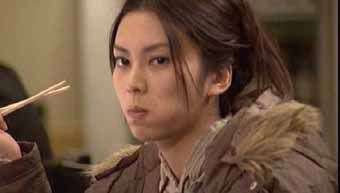
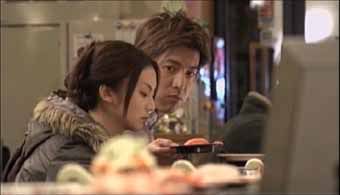
Shinkai wonders how Ogawa can fit so much food into her mouth!
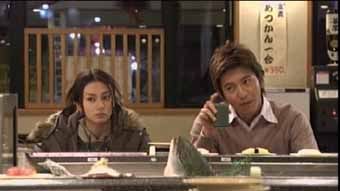
He's stunned by her appetite.
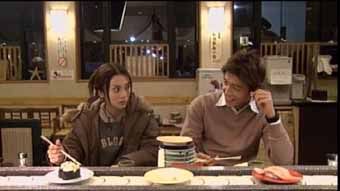
Check out the giant pile of used plates between them - I think they are all Ogawa's!
From Episode 3: When Shinkai enters the same restaurant that Ogawa and her sister Kaori are eating, he clearly wants to join them, but Ogawa's a bit grumpy...food is serious business for her, and not to be interrupted by annoying pilots!
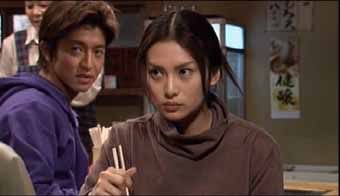
"There you are, eating as though your life depends on it!"
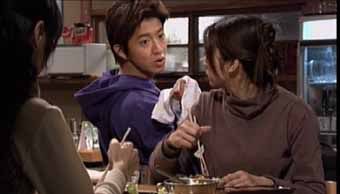
"Are you sure you're going to eat all that?"
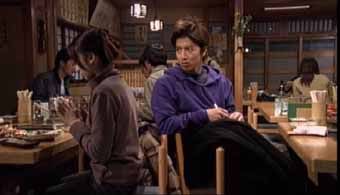
"Really?" ....
All images are from koalathebear's fabulous Good Luck website, but hosted by me.
Now I'm hungry!
In Japan, Food as the Ultimate Show
By Anthony Faiola
Washington Post Foreign Service
Monday, February 27, 2006; A01
TOKYO -- On a quest for the "ultimate ingredients," a team of food explorers from a hit television show here scaled mountains seeking the perfect mushroom and braved stormy seas off Alaska to catch extra-plump salmon. On a rival network, celebrities on "Love's Apron" amuse audiences by bungling complicated recipes. In another local smash, the members of a boy band prepare tasty treats for a constellation of guest stars whose ranks include Prime Minister Junichiro Koizumi.
That's just for starters on Japanese TV, where food shows are what's cooking. In the nation that brought the world "Iron Chef," the programs have become the cash cows of prime time.
Food has long been a major staple of Japanese broadcasting. But with most popular cooking and gourmet shows far cheaper to produce than star-powered dramas, TV producers and researchers say food shows now account for an estimated 35 to 40 percent of all domestic programming.
In this island nation famous for healthy and long-lived citizens rather than bulging waistlines, the shows' popularity underscores a less well-known Japanese obsession: eating.
Indeed, there are few societies where food appears more exalted -- or expensive. Japan is the home of the $15 apple, the $5 piece of chocolate, beef from Kobe and kaiseki ryori -- seasonal delicacies served in numerous small courses and gorgeously presented on decorative bowls and plates. Emphasis is on quality, not quantity, and one pays accordingly. Price tags for such meals can top $400 per person.
Almost every town of any significant size in Japan boasts well-stocked "food souvenir" shops at airports and train stations where visitors snap up regional specialties. Thousands of food pilgrims regularly flock to the countryside in search of seasonal dishes. Japanese travel agencies call food one of the main engines of international travel. Kinki Nippon Tourist, a leading travel agency, peddles scores of popular food-themed escapes, including sweets tours of Taiwan and afternoon-tea trips to Hong Kong.
Chefs, particularly those with their own TV shows, enjoy cult status. At Tokyo's uber-popular La Bettola da Ochiai restaurant, owned by celebrity chef Tsutomu Ochiai, demand for dinner reservations is so high that requests must be made months in advance -- and even then only on the third Sunday of odd-numbered months. Lunch hopefuls form lines hours before opening time.
"The Japanese tend not to mind lining up and waiting if it means you are getting good food," said Kumi Hino, a stylish 43-year-old housewife who arrived at 9:30 a.m. on a recent day to wait in La Bettola's lunch line. For cooking at home, Hino said she buys meat, fish and vegetables at separate outlets, often searching for top-grade ingredients in the vast food basements of Tokyo's grand department stores. "We are highly obsessed about food, we are curious about it, and we are patient," she said.
Japanese also like to look at it.
Particularly in vogue are shows featuring celebrity "food tasters" who travel to towns across the country to sample local delicacies. In what has become a defining moment of domestic TV culture, the camera moves in for a close-up of a glistening mouthful of food dangling scrumptiously off a pair of chopsticks. The morsel then slips into the mouth of a taster, whose eyes go wide before the inevitable exclamation, " Oishii !" -- the Japanese word for delicious.
Presentation and visual appeal are as important as taste. For that reason, food shows must often shoot many takes to capture a morsel's full appeal.
"If the steam isn't blowing off the food in just the right way, people will not be as fascinated and will not see the food as delicious," said Motonobu Nakamura, the director of the "ultimate ingredients" show, "Which Dish?"
"The idea is to make the viewer feel that they are actually eating the food themselves, making it so they can almost taste it," he said.
On Namakura's program, two dishes are prepared using the best ingredients, then a panel decides which one to eat. The show plays to Japanese viewers' focus on the most minute of details. During one recent episode -- grilled salmon vs. miso-marinated mackerel -- commentators tracking down wild salmon in Alaska offered a locator map of migration patterns and a scientific explanation for the development of the fish's reddish-pink flesh. Later, intense close-ups of fat sizzling off the grilling salmon led one commentator to proclaim, "I have never seen such a beautiful thing before."
Food secrets are jealously guarded. One Japanese farmer agreed to lead crew members from "Which Dish?" to his mountain mushroom patch only if they did not disclose the location and blurred out all identifying landmarks. Mushrooms are a recurring theme. In another episode, emotive music accompanied the tale of a farmer's daily struggle to cultivate ever more succulent King Pearl mushrooms using a homegrown mixture of horse manure and hay.
Yet some Japanese wonder whether the daily cornucopia being served up on TV may be one reason for the gradually rising national obesity rate revealed in recent studies.
A proliferation of Western-style fast food and popular instant noodle dishes have received much of the blame. But are all those delicious TV spreads whetting the national appetite a bit too much?
"The Japanese love the culture of food," said Yukio Hattori, who was one of the creators of "Iron Chef" and now has nine food-related shows on the air here. "But we have to be careful. We don't want to lose sight of the need to eat right."
Special correspondent Akiko Yamamoto contributed to this report.
© 2006 The Washington Post Company
http://www.washingtonpost.com/wp-dyn/content/article/2006/02/26/AR2006022601299.html

From Episode 1: I love Ogawa's stuffed chipmunk cheeks!


Shinkai wonders how Ogawa can fit so much food into her mouth!

He's stunned by her appetite.

Check out the giant pile of used plates between them - I think they are all Ogawa's!
From Episode 3: When Shinkai enters the same restaurant that Ogawa and her sister Kaori are eating, he clearly wants to join them, but Ogawa's a bit grumpy...food is serious business for her, and not to be interrupted by annoying pilots!

"There you are, eating as though your life depends on it!"

"Are you sure you're going to eat all that?"

"Really?" ....
All images are from koalathebear's fabulous Good Luck website, but hosted by me.
Now I'm hungry!